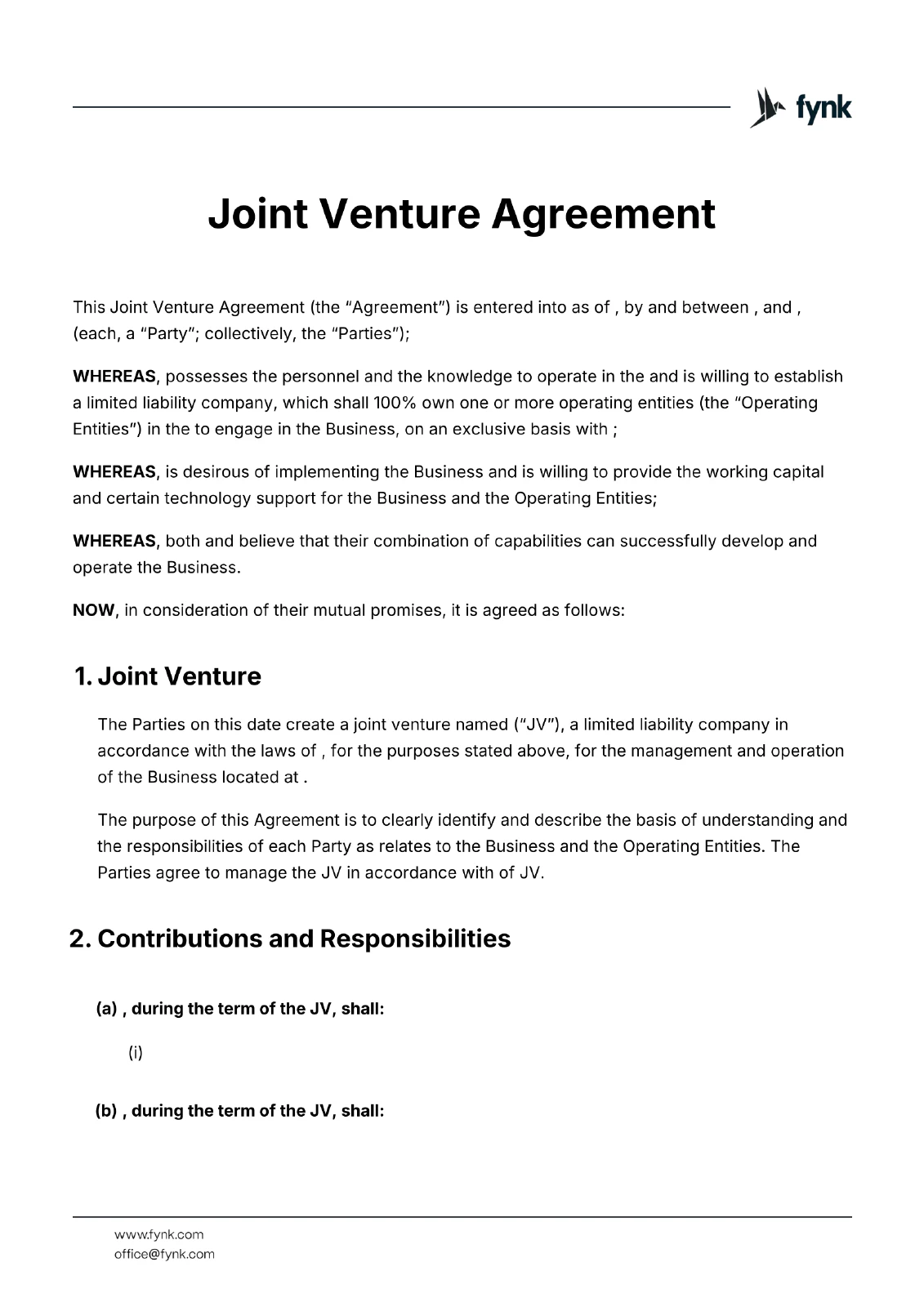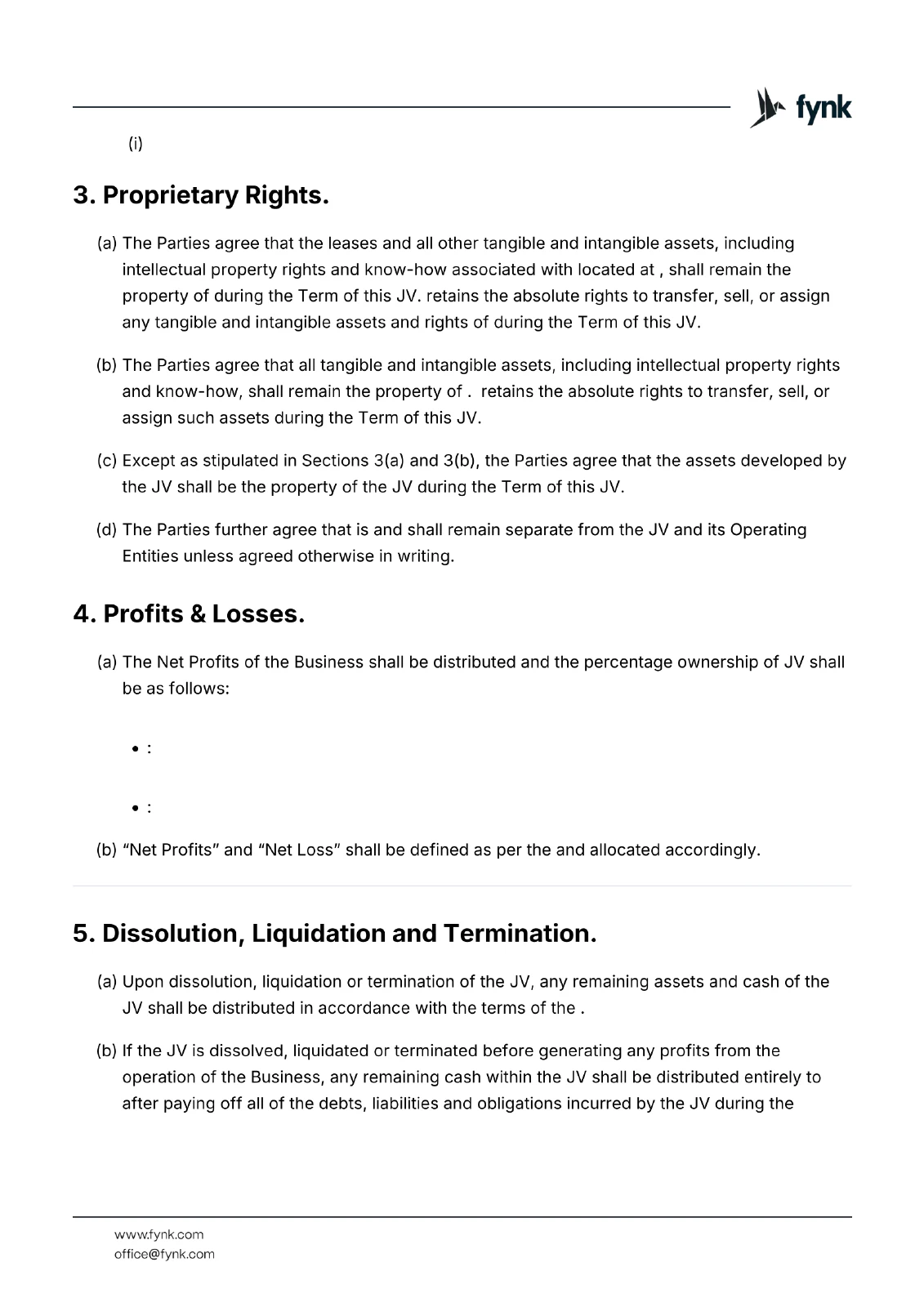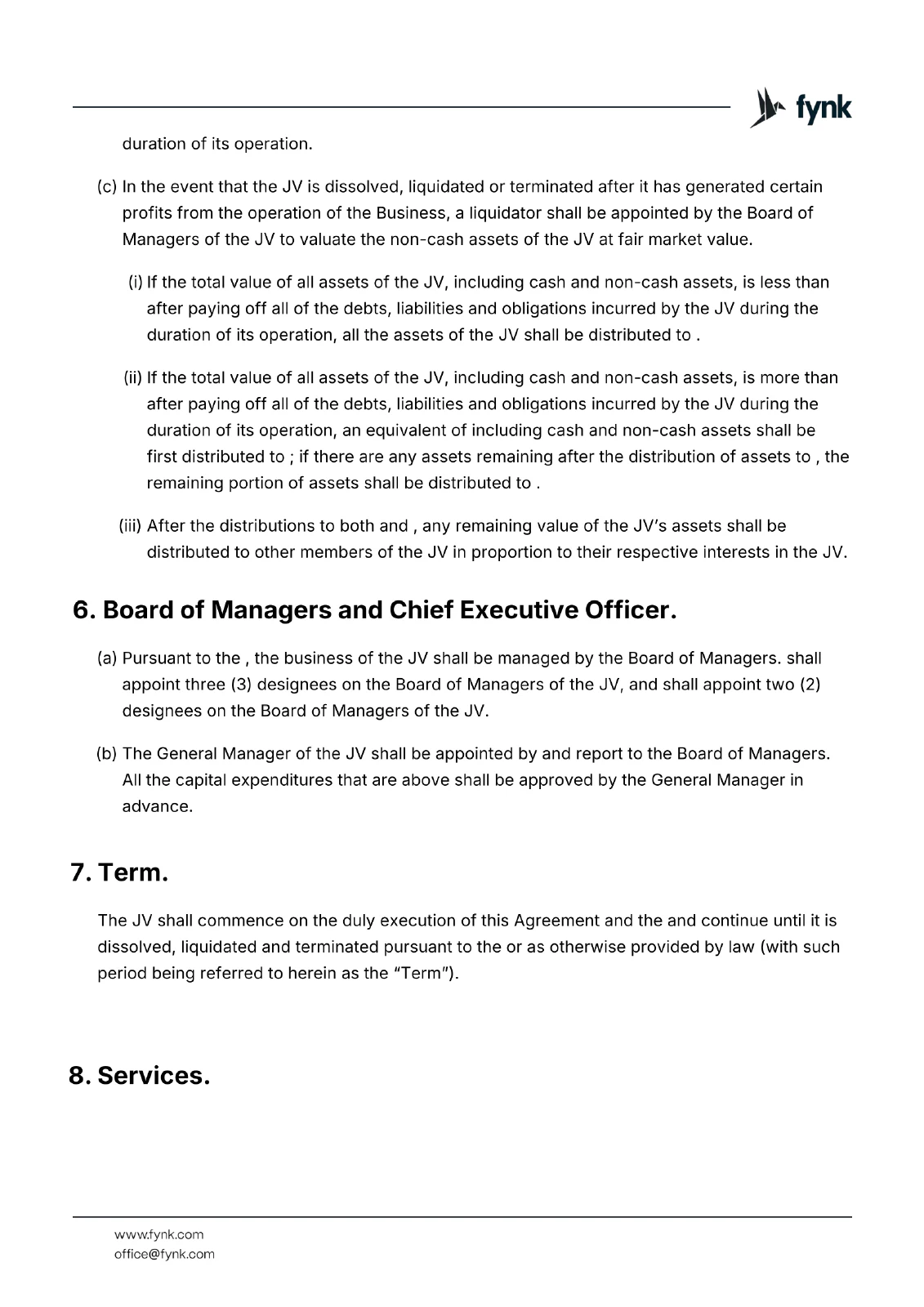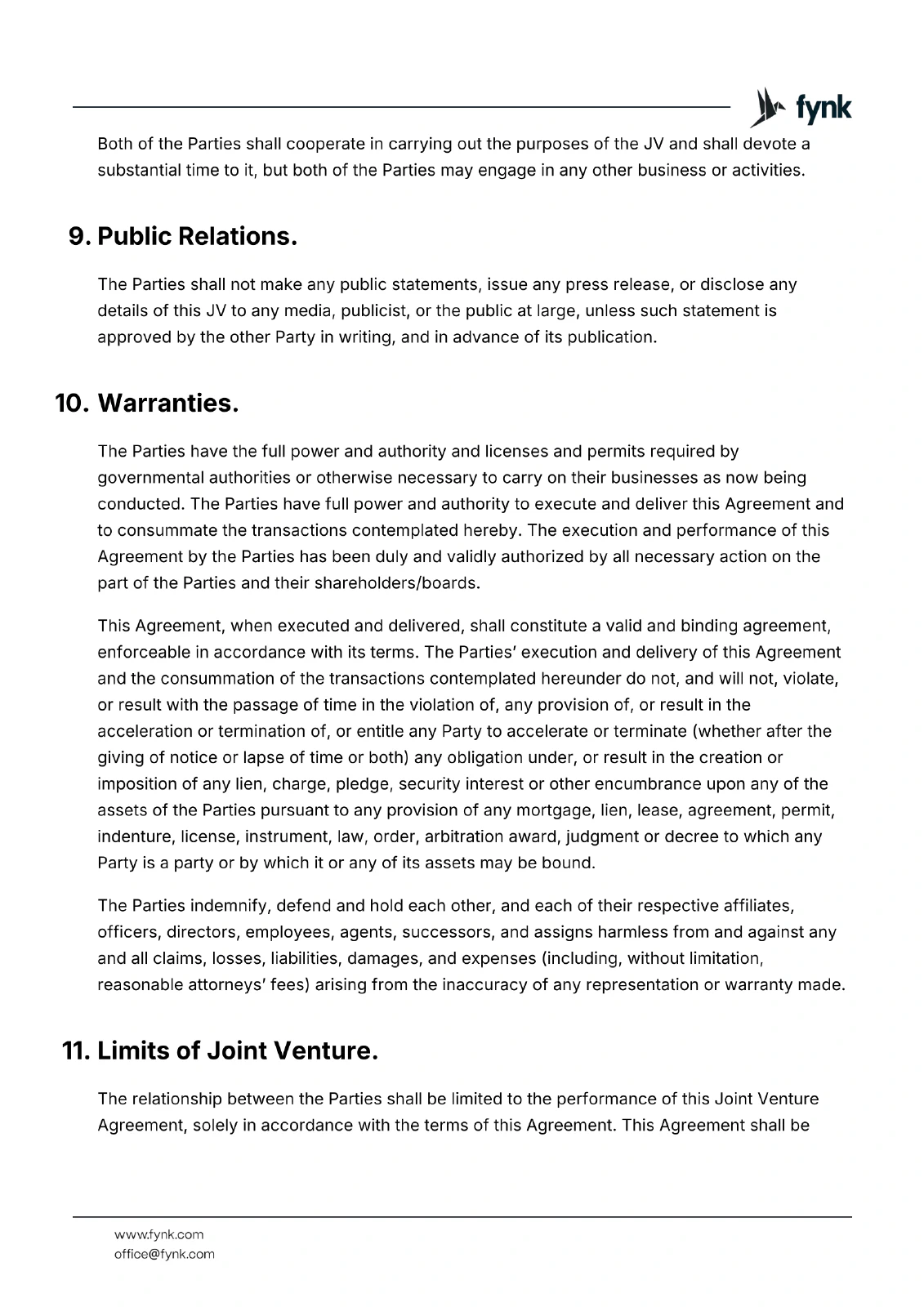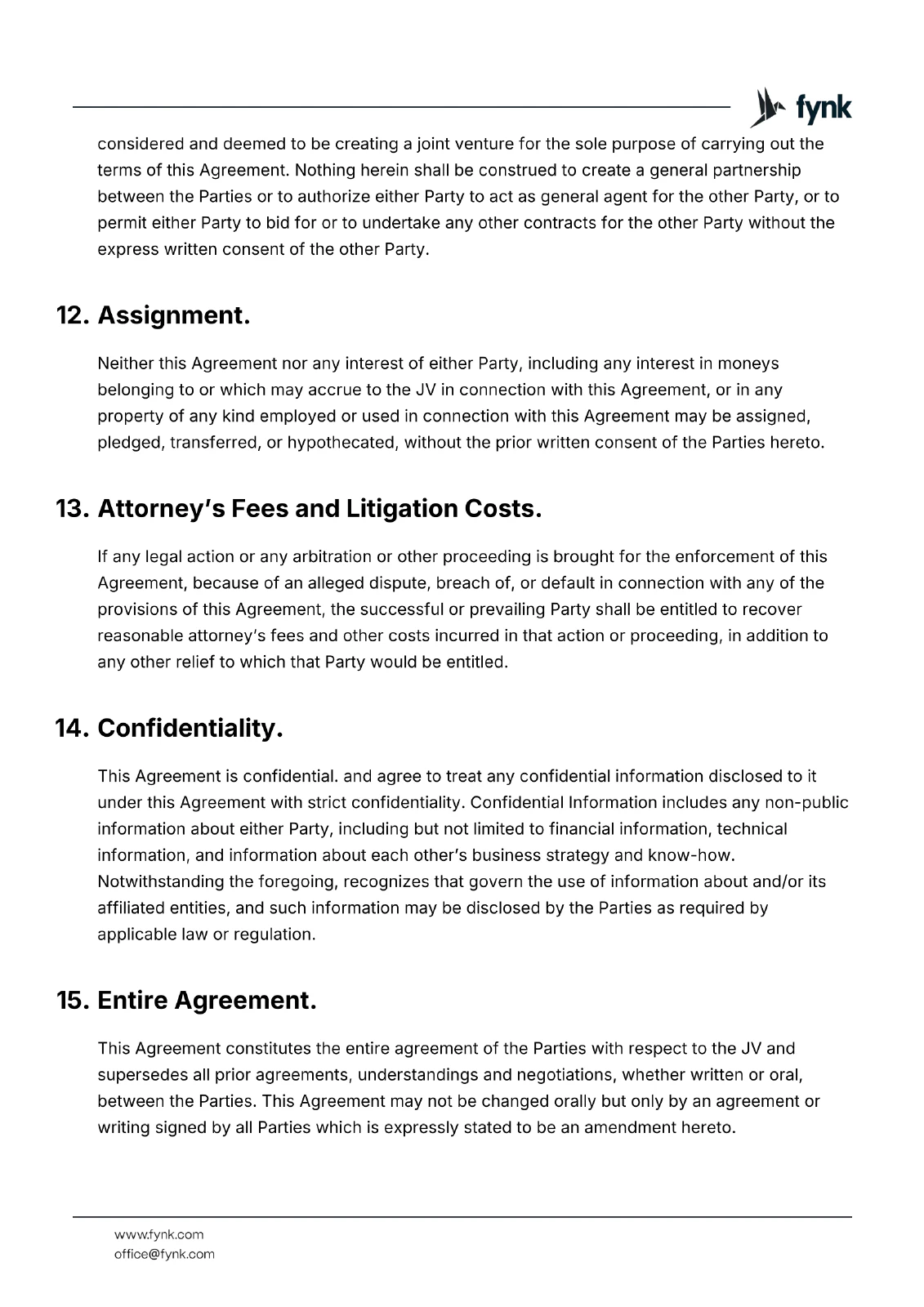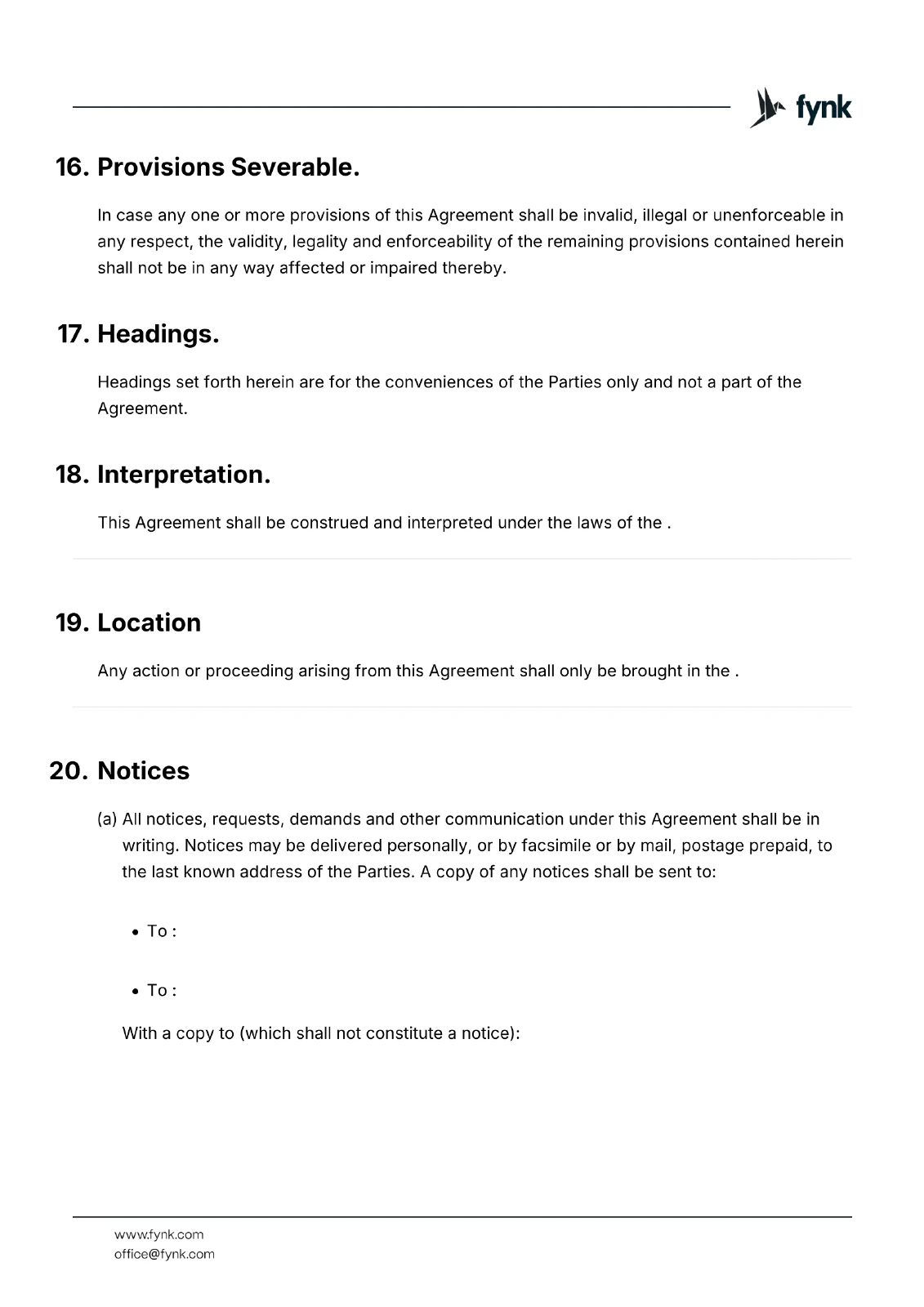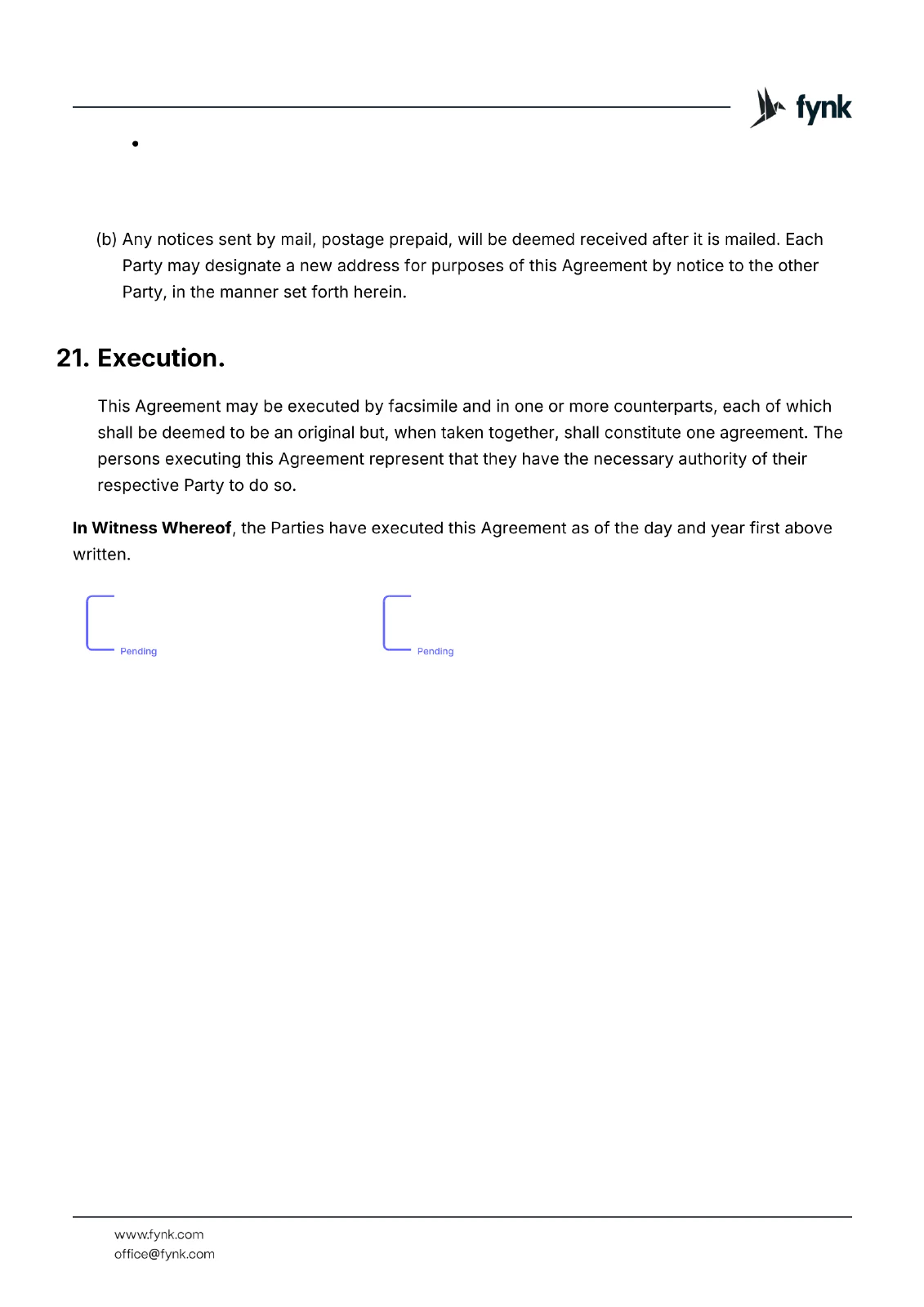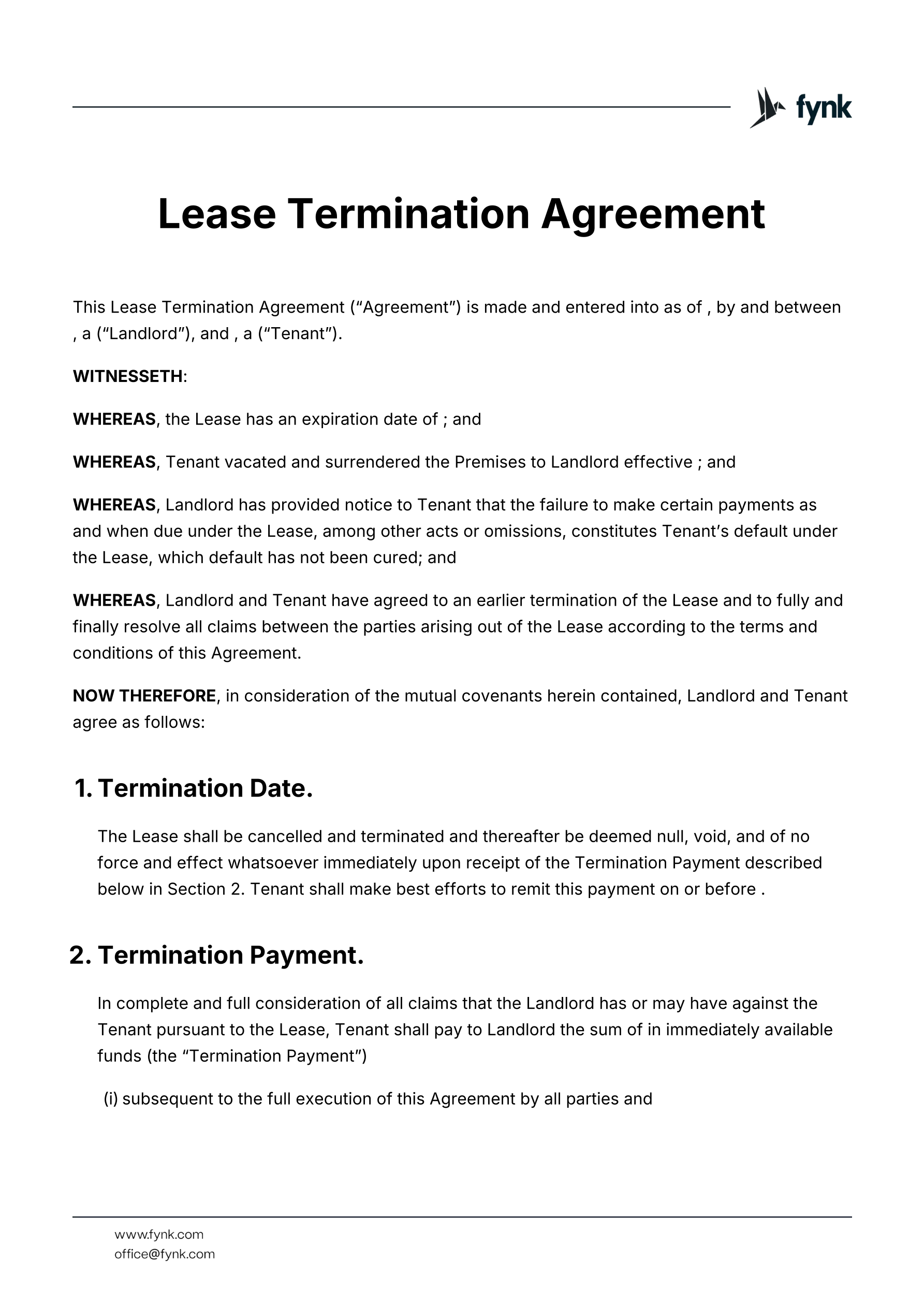Joint Venture Agreement
This Joint Venture Agreement (the “Agreement”) is entered into as of , by and between , and , (each, a “Party”; collectively, the “Parties”);
WHEREAS, possesses the personnel and the knowledge to operate in the and is willing to establish a limited liability company, which shall 100% own one or more operating entities (the “Operating Entities”) in the to engage in the Business, on an exclusive basis with ;
WHEREAS, is desirous of implementing the Business and is willing to provide the working capital and certain technology support for the Business and the Operating Entities;
WHEREAS, both and believe that their combination of capabilities can successfully develop and operate the Business.
NOW, in consideration of their mutual promises, it is agreed as follows:
Joint Venture
The Parties on this date create a joint venture named (“JV”), a limited liability company in accordance with the laws of , for the purposes stated above, for the management and operation of the Business located at .
The purpose of this Agreement is to clearly identify and describe the basis of understanding and the responsibilities of each Party as relates to the Business and the Operating Entities. The Parties agree to manage the JV in accordance with of JV.
Contributions and Responsibilities
, during the term of the JV, shall:
, during the term of the JV, shall:
3. Proprietary Rights.
The Parties agree that the leases and all other tangible and intangible assets, including intellectual property rights and know-how associated with located at , shall remain the property of during the Term of this JV. retains the absolute rights to transfer, sell, or assign any tangible and intangible assets and rights of during the Term of this JV.
The Parties agree that all tangible and intangible assets, including intellectual property rights and know-how, shall remain the property of . retains the absolute rights to transfer, sell, or assign such assets during the Term of this JV.
Except as stipulated in Sections 3(a) and 3(b), the Parties agree that the assets developed by the JV shall be the property of the JV during the Term of this JV.
The Parties further agree that is and shall remain separate from the JV and its Operating Entities unless agreed otherwise in writing.
4. Profits & Losses.
The Net Profits of the Business shall be distributed and the percentage ownership of JV shall be as follows:
:
:
“Net Profits” and “Net Loss” shall be defined as per the and allocated accordingly.
5. Dissolution, Liquidation and Termination.
Upon dissolution, liquidation or termination of the JV, any remaining assets and cash of the JV shall be distributed in accordance with the terms of the .
If the JV is dissolved, liquidated or terminated before generating any profits from the operation of the Business, any remaining cash within the JV shall be distributed entirely to after paying off all of the debts, liabilities and obligations incurred by the JV during the duration of its operation.
In the event that the JV is dissolved, liquidated or terminated after it has generated certain profits from the operation of the Business, a liquidator shall be appointed by the Board of Managers of the JV to valuate the non-cash assets of the JV at fair market value.
If the total value of all assets of the JV, including cash and non-cash assets, is less than after paying off all of the debts, liabilities and obligations incurred by the JV during the duration of its operation, all the assets of the JV shall be distributed to .
If the total value of all assets of the JV, including cash and non-cash assets, is more than after paying off all of the debts, liabilities and obligations incurred by the JV during the duration of its operation, an equivalent of including cash and non-cash assets shall be first distributed to ; if there are any assets remaining after the distribution of assets to , the remaining portion of assets shall be distributed to .
After the distributions to both and , any remaining value of the JV’s assets shall be distributed to other members of the JV in proportion to their respective interests in the JV.
6. Board of Managers and Chief Executive Officer.
Pursuant to the , the business of the JV shall be managed by the Board of Managers. shall appoint three (3) designees on the Board of Managers of the JV, and shall appoint two (2) designees on the Board of Managers of the JV.
The General Manager of the JV shall be appointed by and report to the Board of Managers. All the capital expenditures that are above shall be approved by the General Manager in advance.
Term.
The JV shall commence on the duly execution of this Agreement and the and continue until it is dissolved, liquidated and terminated pursuant to the or as otherwise provided by law (with such period being referred to herein as the “Term”).
Services.
Both of the Parties shall cooperate in carrying out the purposes of the JV and shall devote a substantial time to it, but both of the Parties may engage in any other business or activities.
Public Relations.
The Parties shall not make any public statements, issue any press release, or disclose any details of this JV to any media, publicist, or the public at large, unless such statement is approved by the other Party in writing, and in advance of its publication.
Warranties.
The Parties have the full power and authority and licenses and permits required by governmental authorities or otherwise necessary to carry on their businesses as now being conducted. The Parties have full power and authority to execute and deliver this Agreement and to consummate the transactions contemplated hereby. The execution and performance of this Agreement by the Parties has been duly and validly authorized by all necessary action on the part of the Parties and their shareholders/boards.
This Agreement, when executed and delivered, shall constitute a valid and binding agreement, enforceable in accordance with its terms. The Parties’ execution and delivery of this Agreement and the consummation of the transactions contemplated hereunder do not, and will not, violate, or result with the passage of time in the violation of, any provision of, or result in the acceleration or termination of, or entitle any Party to accelerate or terminate (whether after the giving of notice or lapse of time or both) any obligation under, or result in the creation or imposition of any lien, charge, pledge, security interest or other encumbrance upon any of the assets of the Parties pursuant to any provision of any mortgage, lien, lease, agreement, permit, indenture, license, instrument, law, order, arbitration award, judgment or decree to which any Party is a party or by which it or any of its assets may be bound.
The Parties indemnify, defend and hold each other, and each of their respective affiliates, officers, directors, employees, agents, successors, and assigns harmless from and against any and all claims, losses, liabilities, damages, and expenses (including, without limitation, reasonable attorneys’ fees) arising from the inaccuracy of any representation or warranty made.
Limits of Joint Venture.
The relationship between the Parties shall be limited to the performance of this Joint Venture Agreement, solely in accordance with the terms of this Agreement. This Agreement shall be considered and deemed to be creating a joint venture for the sole purpose of carrying out the terms of this Agreement. Nothing herein shall be construed to create a general partnership between the Parties or to authorize either Party to act as general agent for the other Party, or to permit either Party to bid for or to undertake any other contracts for the other Party without the express written consent of the other Party.
Assignment.
Neither this Agreement nor any interest of either Party, including any interest in moneys belonging to or which may accrue to the JV in connection with this Agreement, or in any property of any kind employed or used in connection with this Agreement may be assigned, pledged, transferred, or hypothecated, without the prior written consent of the Parties hereto.
Attorney’s Fees and Litigation Costs.
If any legal action or any arbitration or other proceeding is brought for the enforcement of this Agreement, because of an alleged dispute, breach of, or default in connection with any of the provisions of this Agreement, the successful or prevailing Party shall be entitled to recover reasonable attorney’s fees and other costs incurred in that action or proceeding, in addition to any other relief to which that Party would be entitled.
Confidentiality.
This Agreement is confidential. and agree to treat any confidential information disclosed to it under this Agreement with strict confidentiality. Confidential Information includes any non-public information about either Party, including but not limited to financial information, technical information, and information about each other’s business strategy and know-how. Notwithstanding the foregoing, recognizes that govern the use of information about and/or its affiliated entities, and such information may be disclosed by the Parties as required by applicable law or regulation.
Entire Agreement.
This Agreement constitutes the entire agreement of the Parties with respect to the JV and supersedes all prior agreements, understandings and negotiations, whether written or oral, between the Parties. This Agreement may not be changed orally but only by an agreement or writing signed by all Parties which is expressly stated to be an amendment hereto.
Provisions Severable.
In case any one or more provisions of this Agreement shall be invalid, illegal or unenforceable in any respect, the validity, legality and enforceability of the remaining provisions contained herein shall not be in any way affected or impaired thereby.
Headings.
Headings set forth herein are for the conveniences of the Parties only and not a part of the Agreement.
Interpretation.
This Agreement shall be construed and interpreted under the laws of the .
Location
Any action or proceeding arising from this Agreement shall only be brought in the .
Notices
All notices, requests, demands and other communication under this Agreement shall be in writing. Notices may be delivered personally, or by facsimile or by mail, postage prepaid, to the last known address of the Parties. A copy of any notices shall be sent to:
To :
To :
With a copy to (which shall not constitute a notice):
Any notices sent by mail, postage prepaid, will be deemed received after it is mailed. Each Party may designate a new address for purposes of this Agreement by notice to the other Party, in the manner set forth herein.
Execution.
This Agreement may be executed by facsimile and in one or more counterparts, each of which shall be deemed to be an original but, when taken together, shall constitute one agreement. The persons executing this Agreement represent that they have the necessary authority of their respective Party to do so.
In Witness Whereof, the Parties have executed this Agreement as of the day and year first above written.

